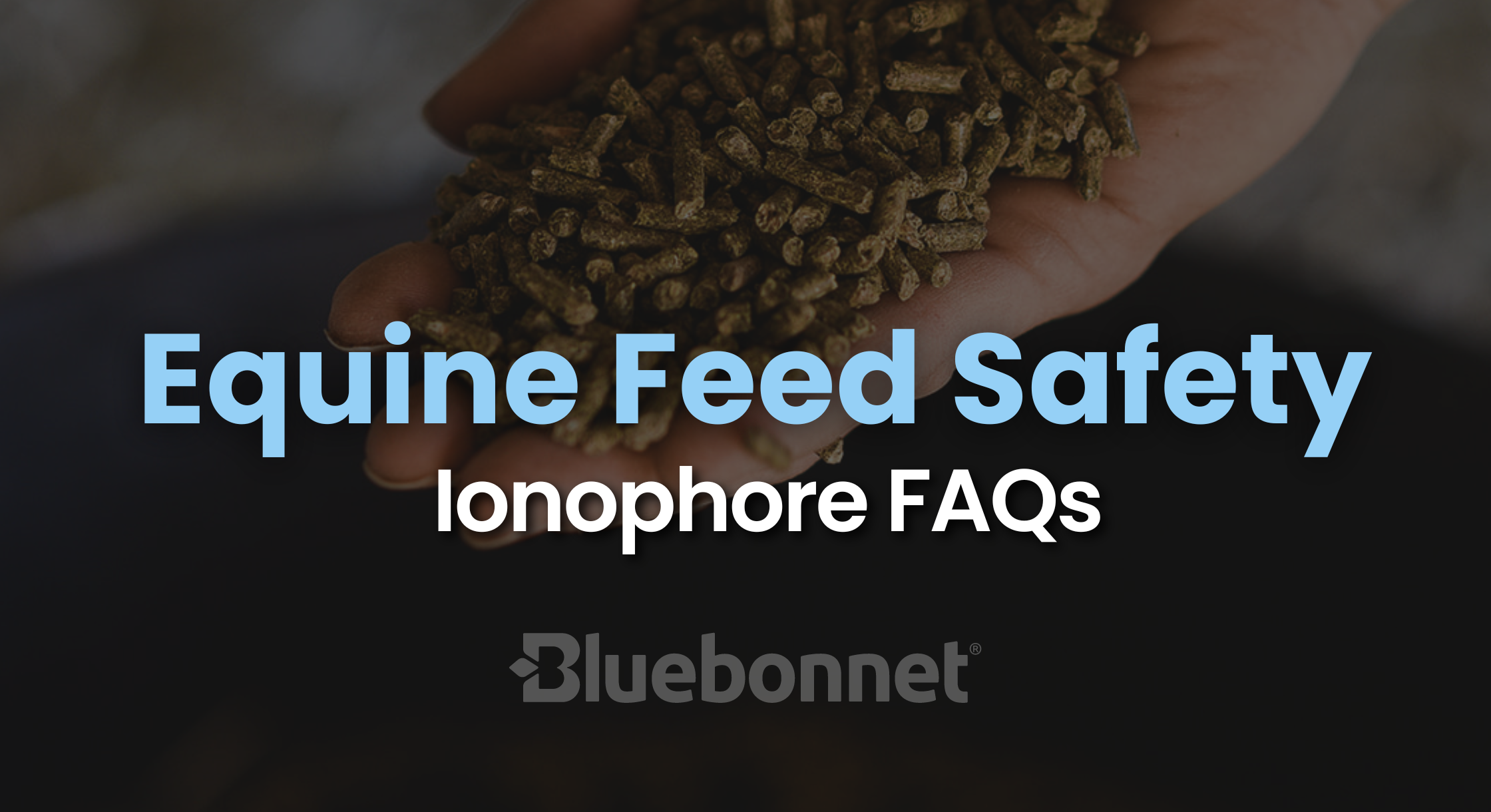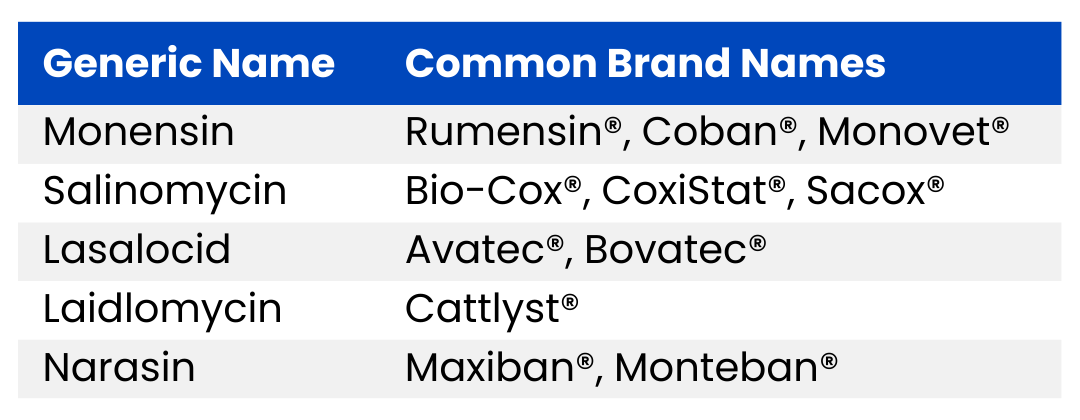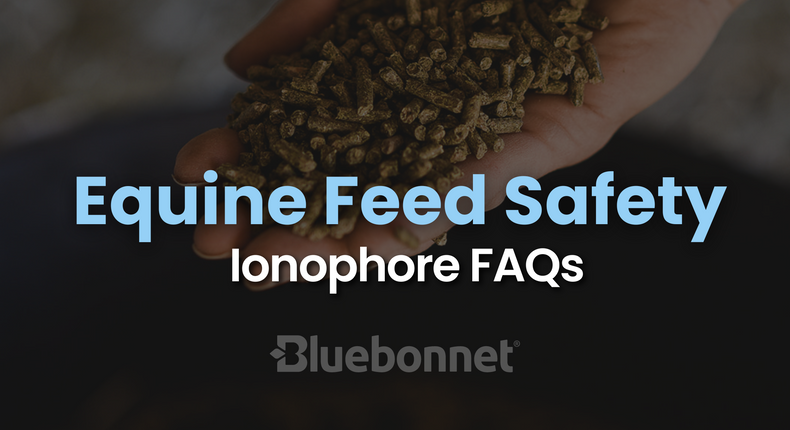
This FAQ is designed to address your most pressing questions about ionophore contamination and offer guidance on how to ensure the safety of your horse's feed.
Q: What are ionophores, and how are they used?
A: Ionophores are commonly added to feed for cattle and species other than horses to improve feed efficiency and prevent coccidiosis. They work by increasing cell membrane permeability, which helps with the transfer of molecules in and out of cells. For more details see this chapter in the Merck Veterinary Manual. Common ionophores used in the U.S. include monensin, salinomycin, lasalocid, laidlomycin, and narasin. Much like Tylenol is a brand name for acetaminophen, ionophores are often referred to by brand names, we’ve listed some common ones below:

Q: How sensitive are horses to ionophores?
A: Horses are much more sensitive to ionophores than other species. For instance, the safety threshold for monensin in horses is under 2-3 mg/kg whereas cattle can tolerate 20-80 mg/kg. As little as 1 gram of ionophore contamination can be fatal to an 1100 lb horse, with extreme illness and loss of life occurring in less than 24 hours after ingestion in severe cases.
Q: What are the signs of ionophore poisoning in horses?
A: Ionophore toxicity may happen as a result of accidental overdose, feed mill mixing errors, or ingestion by a non-target species. Symptoms of ionophore poisoning include poor appetite, diarrhea, muscle weakness, depression, wobbling, colic, excessive urination, sweating, lying down, and sudden death. The toxicity affects the kidneys, skeletal muscles, and heart muscles, leading to system failure. Unfortunately, there is no specific treatment, and horses that survive often suffer from permanent heart damage.
Q: What do I do if I suspect my horse has consumed feed containing ionophores?
A: Waiting is not an option. Contact your veterinarian immediately.
Q: What if I also keep other livestock that require ionophore-containing feed?
A: If you must use ionophore-containing feed for other animals, it is crucial to store it separately from your horse feed. Ensure that the storage area is secure and inaccessible to horses to prevent any accidental ingestion. We recommend feed storage with screw-top lids or clamps so that a curious horse would not be able to gain access. Use dedicated feed storage bins, scoops, and feeders that are boldly labeled.
Q: Are ALL cattle feeds dangerous for horses?
A: No, not all cattle feeds are dangerous for horses. While feeds containing ionophores are a serious risk, some cattle feeds are made with ingredients that are safe for horses. At Bluebonnet, we take extra precautions to ensure the safety and quality of our products. In fact, our cattle feeds are made with horse-safe ingredients, so they do not pose the same risks as those containing ionophores. It's always important to check the ingredients and consult with your feed manufacturer to ensure the safety of your horses.
Q: How can I prevent ionophore toxicity in my horses?
A: Prevention is key. To avoid the risk of ionophore toxicity, purchase feed from manufacturers who have declared their facilities ionophore-FREE. Very few facilities take this step, so it's important to research where your feed is coming from. The mill's name and location are typically printed at the bottom of the feed tag or on the back of the feed bag. We encourage horse owners to contact the mill directly to confirm whether they produce any ionophore-containing feeds.
Q: What’s the difference between an “ionophore-free” mill and an “ionophore-safe” mill?
A: An “ionophore-free” facility does not use ionophores in any feeds for any species, eliminating all risk of contamination. On the other hand, an “ionophore-safe” mill produces some feeds with ionophores and relies on a series of flushes to clean the system before manufacturing horse feeds. However, even with thorough flushing, there is always a risk of cross-contamination and human error. If ionophores are present on the premises, there’s always a chance they could mistakenly be added to horse feed.
Q: Is Bluebonnet an ionophore-free mill?
A: Yes, Bluebonnet is proud to be an ionophore-FREE mill. We prioritize the safety of your horses above all else, ensuring that no ionophores are allowed on our property.
Q: How do I know my horse feed is made in an ionophore-free facility?
A: Most feed companies that are ionophore-free are proud to share it with their customers. If you can not find the information on their website, we recommend calling them for clarification on the information shared above.
Q: What questions should I ask or what should I clarify when inquiring about my feed company’s ionophore stance?
A: Open-ended questions such as: “What ionophores are allowed on your property?” The answer to this question immediately lets the caller know if the facility is ionophore-safe or ionophore-free. (If the mill says they are a monensin-free facility, follow up with inquiries about other ionophores.)
If you have any further questions or need more detailed information about ionophores and feed safety, our team of nutrition consultants at Bluebonnet is here for you. Please feel free to reach out to us for any additional assistance or clarification. ➡ https://bluebonnetequine.com/nutrition-consult
Resources:
Oklahoma State University Extension
Additional Information:

